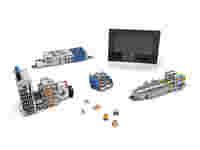Polyamide (PA66)
WAGO uses modified, technically halogen-free, flame-retardant polyamides.
These materials do not corrode, are difficult to ignite and feature self-extinguishing properties (V0 rating per UL 94). Adhering to UL 746C, the polyamides used at WAGO have a continuous operating temperature of 105 °C (221 °F) based on the relative temperature index with impact load (RTIimp).
This ensures that the necessary electrical and mechanical insulating properties are maintained at a sufficiently guaranteed level over a long period of time. The short-term upper temperature limit is
200°C (392°F). In lower temperature ranges, it has been determined that no damage to the insulation material occurs during usage down to −35°C (−31°F). After installation and wiring, WAGO products can even be used at temperatures down to −60°C (−76°F). Environmental humidity (up to 2.5 % in a standard atmosphere) is absorbed, providing the polyamides with optimum elasticity, strength and durability. In practical use, basic stabilization of WAGO’s polyamides has been proven over many years to be sufficient to prevent damage caused by ozone or UV radiation exposure in intended applications. Polyamides have excellent resilience against the most demanding climates and have proven themselves in tropical applications worldwide. Insulation parts made of polyamide are resistant to insects. The material does not provide oxygen or other biogenic elements to microorganisms. The presence of anaerobic earth bacteria, mold, fungus and enzymes does not degrade the material. Polyamides are resistant to most fuels, greases and oils, as well as the most commonly used cleaners, such as alcohol, Freon, Frigen and carbon tetrachloride. Acid resistance depends on the acid type and concentration, as well as the exposure time.
The use of insulation materials during in-house production at WAGO only occurs after acceptance of factory test certificates and specified material tests.
Glass Fiber-Reinforced Polyamide (PA 66 GF)
WAGO uses glass-fiber-reinforced polyamides for components with increased mechanical demands, such as levers, push-buttons or housings exposed to high stresses, because they have significantly better mechanical characteristic properties than non-reinforced polyamides. In general, materials are used that have excellent tracking resistance, flammability ratings and high temperature resistance.
More data can be found in the table.
Polyphthalamide (PPA GF)
Glass-fiber-reinforced, high-performance polyamides are ideal for high-temperature applications, due to the material’s high level of thermal dimensional stability, its low dependence on ambient conditions and its excellent strength properties. The material’s outstanding tracking resistance permits miniature components to be realized. Fire protection equipment enables classification in flammability class V0 per UL 94 – even for extremely thin walls. PPA GF absorbs minute amounts of moisture from the ambient air, making it ideal for THR soldering applications and for thin-walled, dimensionally stable components.
More data can be found in the table.
Polyamide (PA46)
In comparison with PA 66, PA 46 has substantially higher dimensional stability under heat. The relative temperature index with impact load (RTIimp) is 115°C (239°F) for PA 46.
The reliable short-term temperature for the type used by WAGO is 280°C (536°F).
More data can be found in the table.
Polycarbonate (PC)
Polycarbonate has excellent dimensional stability under heat. The electrical and mechanical properties remain intact at extremely high temperatures up to approximately 120°C (248°F) per UL Yellow Card. Its excellent electrical insulating properties and dimensional stability are virtually independent of environmental conditions, such as humidity and temperature. Highly precise components can be created due to the low shrinkage of the material during injection molding. Polycarbonate has excellent weather resistance and is also highly resistant to high-energy radiation. If the PC is not colored, then the components are glass-clear. Thanks to its desirable properties (e.g., dimensional stability, heat resistance, non-flammability, durability and transparency), PC is a proven and widely used material in the electrical industry. Depending on the demands placed on the finished product, WAGO uses polycarbonates that carry flammability classifications V2 and V0 per UL 94. Medium-viscosity PC is used that features excellent chemical resistance.
Polybutylene Terephthalate (PBT)
Polybutylene terephthalate is used due to its balanced combination of rigidity and strength alongside durability and heat deflection resistance, as well as excellent dimensional stability.
The electrical and mechanical properties are on a high level and are not affected ambient humidity. The fire protection equipment is technically pollutant-free as usual, and the material is classified as V0.
Glass-Fiber-Reinforced Polybutylene Terephthalate (PBT GF)
Glass-fiber-reinforced polybutylene terephthalate is also distinguished by very good mechanical and electrical properties, especially with thin walls.
Type PBT GF is also classified as V0 and and, like the other WAGO plastics, technically pollutant-free.









